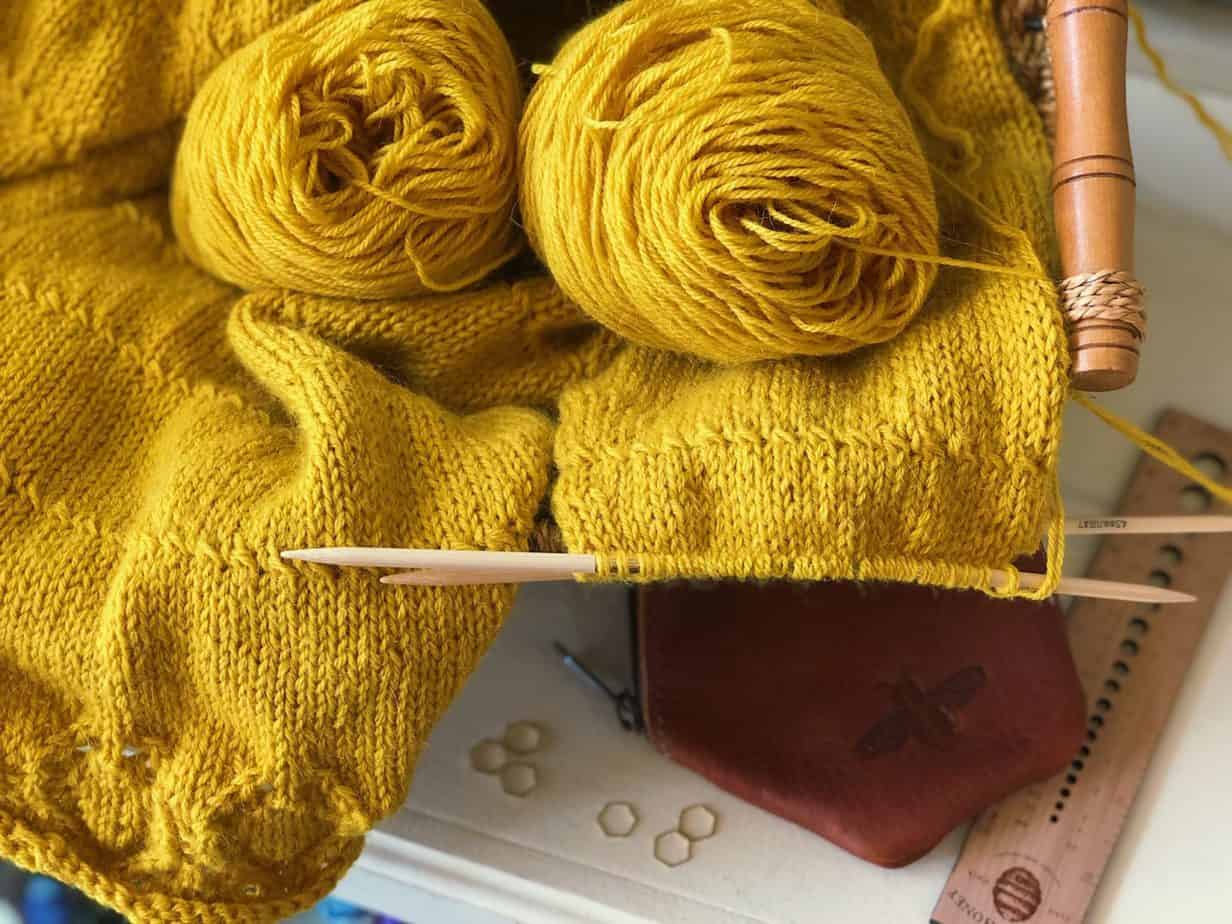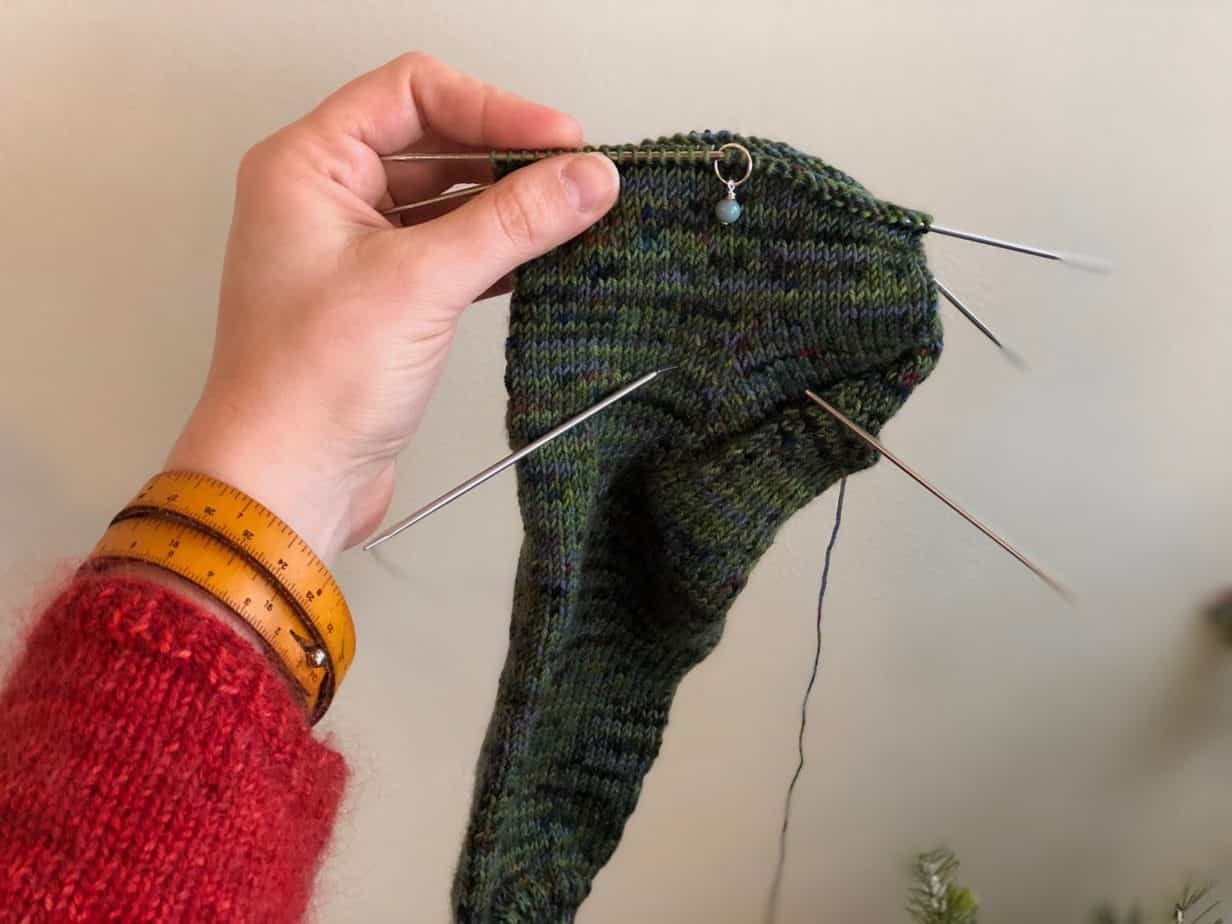Y’all. We’re so glad we’re not the only Makers who struggle with self-control. Between conversations in the shop and comments on Instagram, Facebook and here on the blog, it looks like our latest post about the Gideon Method is striking a hauntingly familiar chord with many of you.

We’ve had a few questions on how to make modifications, exceptions, etc, so we thought we’d write another post. Consider this an addendum of sorts–The Gideon Method, Pt.2.
- No. This isn’t forever. Or at least, it doesn’t have to be, if that’s not what you want. The Gideon Method can be the new way you balance your creativity–forever–or it can just carry you through a phase of disorderly chaos. You can use the Gideon Method for the rest of your days, or just while you navigate a season of life. (Liz and I both think we’ll keep going in this way indefinitely.)
- What happens when unexpected things crop up? And yes. Yes, they will. Creative pursuits you haven’t planned for yet. Knit-A-Longs. New yarn you just can’t stop yourself from buying. You might become a weaver. Someone you know is going to get pregnant with triplets. Your spouse’s boss’s wife’s cousin will want to hire you to crochet a shawl for Christmas–but you won’t know that until Thanksgiving. Occasionally–and again, this is your life, so you’re going to have to decide how often you’ll make these exceptions–you’ll put everything on hold to cast on something new and knit like the wind. Until you finish or until you fizzle out–that’s your call.
- No, you do not have to stick with the 12-hour time limit. If you’re not a large project knitter (say, mostly a hat knitter), then maybe 12 hours per project is too long for you. Perhaps a 6-hour time limit is best for your lifestyle. However–and this is important–you cannot bounce between different time limits for different projects. If you choose 6 hours as your threshold, then it’s 6 hours across the board–not ‘6 hours for hats, 12 hours for sweaters, 4 hours for socks’ etc. Because otherwise, what would differentiate the Gideon Method from your normal method of….doing whatever you want? The goal with the Gideon Method in general is to create some firm-yet-loving boundaries that gently (subconsciously?) coax you into organizing your knitting life into manageable chunks. You’re going for more structure in your life, because–and I hate to have to be the one to tell you this–if you’re nodding your head while you’re reading this, you don’t have it.
- You can, however, tack on extra time to a project if that’s the final push it takes to finally finish something. You just can’t quit early. This is the part where we talk about tough love. If you want the Gideon Method to be more than a fad or a passing fancy–if you want to make a true lifestyle commitment and discover a way to permanently harness your creativity while maintaining a semblance of organization and completion in your life–you have to do the work. It won’t be a challenge to you–and in turn, become physically and emotionally fulfilling in a very real way–if you don’t push yourself.
- However. You can be flexible. You really can. As in Life. Because of course, you’re the one making the rules here. You need to be gentle with yourself; Life isn’t about making lists and ticking things off to Get Ahead. That isn’t why you fell in love with Making, and it certainly won’t keep the fires burning. In fact, that might be the quickest way to burnout. For most of us, turning our creative life into an Excel spreadsheet simply feels wrong. Just remember, though, when you’re giving yourself a free pass to cast on your 14th new project in 10 days, what brought you to consider this method in the first place. Knitter, KNOW THYSELF. When you recognize what’s happening, ask yourself what you really want in that exact moment (the freedom to start something new? the victory of finishing something that’s been lingering?) and reassess. Repeat as necessary. Personally, I’ve been living so long without seeing real progress on my own knitting projects that everything feels lackluster. When you have 18 projects on the needles (and truly, I’m certain that’s a gross underestimation), your life starts to look a little like, ‘twenty minutes on this sock here, an hour spinning fiber once a month, three rows on this sweater–set it down for two months’, etc. etc. and you end up finishing nothing and getting overwhelmed by everything. You need to–I need to–be able to experience the joy and deep satisfaction of finishing, and not just once or twice a year. If you’re a person who works with their hands, finishing should be a regular occurrence and again, sometimes too much of a good thing really is too much (I am, of course, referencing the constant and burning desire to cast on at random); making yourself work for something once in awhile? Sticking to a deadline? Pushing yourself to finish when you know it really is the right thing to do? When you actually do it, you might just realize you posses the power of a Greek goddess.
- Yes, there is such a thing as a freebie. And no, it’s not cheating. You can–you should–have something going at all times that doesn’t count against your number. Something for waiting in line, for emergency room visits, for social stitch circles, for the daily commute, when your nervous hands need something to do but you can’t even count to ten, for when your current sweater is too big to lug around. Something that’s small enough to fit in your purse or your backpack, something that goes everywhere you do. There is no time frame nor expectation for this project; sometimes you need something to knit because your current project is too big/complex/awkward to tote around, but you can’t just sit with your hands in your lap. I’m transitioning my Plaid Friday socks into my freebie (something I can knit on while customers are browsing in the store or I’m on hold with the insurance company), and Liz has a simple hat going with our January Sleeping Bear Yarn Club selection for our U of M grad brother-in-law, who will go crazy for the maize and blue. They’ve recently (albeit temporarily) become a one-car family, and despite having the initial reaction one gets when they discover they’re about to gain scads of free knitting time (around here, we call that elation), she quickly discovered her husband is very allergic to alpaca. Ahem. She can’t knit her KAL in the car, so she’s doing her commuter knitting on a freebie project instead.

Above all, have fun. If establishing some parameters for your creativity is actually giving you more freedom (raises hand), then great. Keep going. If it’s not, and it’s starting to feel like your joyful hobby is all work and no play, then scrap it. This is your life. Make it beautiful.
(And in case you missed it, the original post about the Gideon Method can be found right HERE.)


B
Thanks so much for these posts. My WIPs are taking up an enormous area of my closet and after weeding out the old, no longer interested in finishing ones from the rest, I have nearly 20 projects I want to finish. I’ve been practicing the Gideon method since your initial blog was posted and I’m now very close to completion on two sweaters!!!! I believe the Gideon method may be my ticket out of WIP hell. It’s working for me!!!
Dannielle
Spot on again! I’m in love with this method and am using its principles at work as well. This is even helping me finish a cross stitch project that’s been sitting in its storage container for over a decade; it’s in the queue!
Catherine
Thank you for posting this–what a great method! I’m going to apply it to ALL my current WIPs: embroidery, knitting, quilting, sewing.
Deborah Kuppusamy
Just finished a pair of socks last night! I’m a complete convert now. I’ve made an actual WIP list and will work from that. And I do have a”freebie” in my work tote. Thanks for the post and encouragement.
Diane
I recently finished a Whack-a-Whip KAL with my Team Michigan Ravelry group, and finished off everything I had on needles at that time. No worries. I immediately cast on a hat and two sweaters. I have the yarn, needles and pattern set up for two more items—a vest, and a hat—and in my mind these are WIPs already. So I began the Gideon Method after your first post, and am nearing completion on the hat, which I’ve worked on for about eight hours. Since Ingenerally knit about two hours a day, the Gideon method is perfect for me—about 6-7 days per project, long enough to make real progress but short enough to begin looking forward to the next project on the list.
Science tells us that we get an endorphin hit every time we finish a project of any sort, big or small. I think the GM will give us both discipline and that feel-feel-good-get-it-done boost we all want and need. Thank you so much! I would never have come up with this on my own.
Beth Mak
Off-topic question: do you an ‘events’ calendar for 2020, with guests, similar to 2019?
Melissa and Liz
Hi Beth! Yes, we’re working on a few–do check out our Events page, and soon soon soon we’ll be adding more! Stay tuned!
Sarah
I cannot tell you how much unfinished project bother me. They sit in the back of my mind and cause so much guilt, but it doesn’t seem to stop me from starting new ones. . I was so excited to read your first blog post on the method and loved this one too. I modified a bit as I have an 8 month old and put 3 projects around the house around where we most commonly play. So I just work on those so I don’t have to drag them around with me and work only on one at a time at night or during naps for the 12 hour limit. I’ve finished a sweater that was only missing one (1!!!!) sleeve for two years and am close to finishing 3 other projects. This is such a joy.
Jenni
I love this so much! I started doing this for myself after your first blog post about it. I also thought about 6 hours, but after actually working on something, decided that 12 was a great number. I’ve been able to finish 2 projects and make good progress on another two so far! I did make an exception that I could always have ONE sock project to carry around that doesn’t count on my list. It’s so nice to actually get some of my wips off the needles and to reevaluate others that need to be frogged. Thanks for the inspiration! ?
Ellen
I really liked both of these blogs…..great ideas and information. While I typically don’t have more than 2 WIP’s going at any given time, I can see where it could happen. I think this is going to be helpful so that I can actually start more projects. I usually get bored with the 2 I have going, and don’t start more for fear of not finishing the others. But this would help remedy both issues.
Thanks!
Cheryl
I read about the “Gideon Method Part 1” and adapted it for my own. Then I shared it with my knitting group. It freed me from feeling guilty about little projects languishing on the needles, and it also gave me the push I needed for getting a lace sweater done that I kept dreading because. I am SO over it! Great technique for those of us that like to start many projects.
Anne
Thank you for sharing the Gideon Method! I started it after the first post and have already finished two projects that had been on the needles for a long time. It’s amazing how much you can accomplish in under 12 hours!
Gretchen Borst
Please make a peg board out of gorgeous wood that could keep track of my hours and my 5 projects. You all are so creative: if anyone could do it beautifully, it would be you! The Gideon Method needs to be solidified for the Makers in this world with big numbers of projects and slow-to-no completions:)
Dorce Campbell
As of today I am going to start the Gideon method. I really need to finish some project the have been sitting waiting to be finished. So here I go. Will also have a socks fore soldiers going for 20 minutes a day.
x
Thank you so much for this informative article. It is truly a God send. It has helped me to organize my WIPs and viewing casting/knew projects with an eye toward completion. This will hopefully prevent me from becoming overwhelmed and using an alternate project/craft hobby as a freebie.
Caitlin
Thank you … As a multi crafter I have too many projects on the go. But I’m going to focus down on a few that I want finished. I want to finish them and this method may just help.